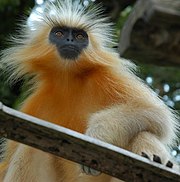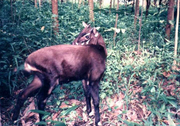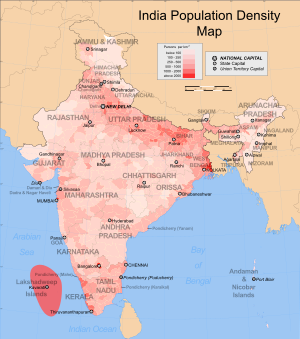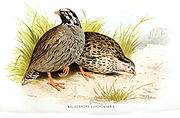GEN101:India as a megadiverse nation
India is one of the richest countries in the world in terms of biodiversity. This natural variation in life is also reflected in the demography of the land. Although the causes behind biodiversity and demographic diversity are different, the human population of the land has depended on the biodiversity in many ways for a long time. At the same time, today, the excessive human population of India is leading to a survival pressure on the biodiversity. Thus, it is important to know and appreciate the diversity in both - human population and flora and fauna.
Contents
Demographic diversity of India
India is a remarkably diverse country. Arguably, only the continent of Africa exceeds the linguistic, genetic and cultural diversity of the nation of India.[1]. The country houses 1.18 billion people speaking 1652 languages and dialects[2], spread out over more than two thousand ethnicities and over every major religion.
The demographics of India are remarkably diverse. India is the second most populous country in the world, with over 1.18 billion people (estimate for April, 2010), more than a sixth of the world's population. Already containing 17.31% of the world's population, India is projected to be the world's most populous country by 2025, surpassing China, its population exceeding 1.6 billion people by 2050.[3][4] However, India has an astonishing demographic dividend where more than 50% of its population is below the age of 25 and more than 65% hovers below the age of 35. It is expected that, in 2020, the average age of an Indian will be 29 years, compared to 37 for China and 48 for Japan; and, by 2030, India's dependency ratio should be just over 0.4.[5]
This demographic diversity of India is both good and bad for its biodiversity. Bad because of the enormous pressure the human population puts on the natural resources. And good because this human diversity has resulted in a plethora of customs, traditions and rituals in the context of native species. Plants and animals are considered sacred (eg: Ocimum tenuiflorum or Tulsi) or find mentions in mythological stories (eg: Elephas maximus indicus or Indian Elephant) or are used in religious rituals (eg: Nelumbo nucifera or Indian Lotus). These deep associations between biodiversity and culture presents us with a unique opportunity for their conservation.
Flora and fauna of India
India is a country rich in biological diversity. It lies within the Indomalaya ecozone and houses two of the 34 biodiversity hotspot in the world[6].
There is a huge species diversity in India, with several of the species being endemic to the their native ranges in India[citation needed].
| Group |
Number |
% of world species |
| Mammals |
350 |
7.6% |
| Birds |
1224 |
12.6% |
| Amphibians |
197 |
4.4% |
| Reptiles |
408 |
6.2% |
| Fishes |
2546 |
11.7% |
| Flowering plants |
15000 |
6% |
Sources: Indira Gandhi Conservation Monitoring Centre (IGCMC), New Delhi [7] and IISc [8]
Many Indian species are descendants of taxa originating in Gondwana, to which India originally belonged. Peninsular India's subsequent movement towards, and collision with, the Laurasian landmass set off a mass exchange of species. However, volcanism and climatic change 20 million years ago caused the extinction of many endemic Indian forms.[9] Soon thereafter, mammals entered India from Asia through two zoogeographical passes on either side of the emerging Himalaya.[10] As a result, among Indian species, only 12.6% of mammals and 4.5% of birds are endemic, contrasting with 45.8% of reptiles and 55.8% of amphibians.[11] Notable endemics are the Nilgiri leaf monkey and the brown and carmine Beddome's toad of the Western Ghats.
Biodiversity vs Human progress

India contains 172, or 2.9%, of IUCN-designated threatened species.[12] These include the Asiatic lion, the Bengal tiger, and the Indian white-rumped vulture, which suffered a near-extinction from ingesting the carrion of diclofenac-treated cattle.
In recent decades, human encroachment has posed a threat to India's wildlife; in response, the system of national parks and protected areas, first established in 1935, was substantially expanded. In 1972, India enacted the Wildlife Protection Act and Project Tiger to safeguard crucial habitat; further federal protections were promulgated in the 1980s. Along with over 500 wildlife sanctuaries, India now hosts 15 biosphere reserves, four of which are part of the World Network of Biosphere Reserves; 25 wetlands are registered under the Ramsar Convention.
The need for conservation of wildlife in India is often questioned because of the apparently incorrect priority in the face of direct poverty of the people. However Article 48 of the Constitution of India specifies that, "The state shall endeavour to protect and improve the environment and to safeguard the forests and wildlife of the country" and Article 51-A states that "it shall be the duty of every citizen of India to protect and improve the natural environment including forests, lakes, rivers, and wildlife and to have compassion for living creatures."[13]
Biodiversity hotspots
A biodiversity hotspot is a biogeographic region with a significant reservoir of biodiversity that is under threat from humans. To qualify as a biodiversity hotspot on Myers 2000 edition of the hotspot-map, a region must meet two strict criteria: it must contain at least 0.5% or 1,500 species of vascular plants as endemics, and it has to have lost at least 70% of its primary vegetation.[14] Around the world, at least 25 areas qualify under this definition, with nine others possible candidates. These sites support nearly 60% of the world's plant, bird, mammal, reptile, and amphibian species, with a very high share of endemic species.
Three regions that satisfy these criteria exist in India and are described below. For a more detailed information about these hotspots, go to the Biodiversityhotspots.org homepage
The Western Ghats and Sri Lanka
The Western Ghats are a chain of hills that run along the western edge of peninsular India. Their proximity to the ocean and through orographic effect, they receive high rainfall. These regions have moist deciduous forest and rain forest. The region shows high species diversity as well as high levels of endemism. Nearly 77% of the amphibians and 62% of the reptile species found here are found nowhere else.[15] The region shows biogeographical affinities to the Malayan region, and the Satpura hypothesis proposed by w:Sunder Lal Hora suggests that the hill chains of Central India may have once formed a connection with the forests of northeastern India and into the Indo-Malayan region. Hora used torrent stream fishes to support the theory, but it was also suggested to hold for birds.[16] Later studies have suggested that Hora's original model species were a demonstration of convergent evolution rather than speciation by isolation.[15]
More recent phylogeographic studies have attempted to study the problem using molecular approaches.[17] There are also differences in taxa which are dependent on time of divergence and geological history.[18] Along with Sri Lanka this region also shows some faunal similarities with the Madagascan region especially in the reptiles and amphibians. Examples include the Sibynophis snakes, the [w:Purple frog|Purple Frog]] and Sri Lankan lizard genus Nessia which appears similar to the Madagascan genus Acontias.[19] Numerous floral links to the Madagascan region also exist.[20] An alternate hypothesis that these taxa may have originally evolved out-of-India has also been suggested.[21]
Biogeographical quirks exist with some taxa of Malayan origin occurring in Sri Lanka but absent in the Western Ghats. These include insects groups such as the zoraptera and plants such as those of the genus Nepenthes.
The Eastern Himalayas

The Eastern Himalayas is the region encompassing Bhutan, northeastern India, and southern, central, and eastern Nepal. The region is geologically young and shows high altitudinal variation. It has nearly 163 globally threatened species including the One-horned Rhinoceros (Rhinoceros unicornis), the Wild Asian Water buffalo (Bubalus bubalis (Arnee)) and in all 45 mammals, 50 birds, 17 reptiles, 12 amphibians, 3 invertebrate and 36 plant species. [22][23] The Relict Dragonfly (Epiophlebia laidlawi) is an endangered species found here with the only other species in the genus being found in Japan. The region is also home to the Himalayan Newt (Tylototriton verrucosus), the only salamander species found within Indian limits.[24]
Indo-Burma

The Indo-Burma region encompasses several countries. It is spread out from Eastern Bangladesh to Malaysia and includes North-Eastern India south of Brahmaputra river, Myanmar, the southern part of China's Yunnan province, Lao People’s Democratic Republic, Cambodia, Vietnam and Thailand. The Indo-Burma region is spread over 2 million sq. km of tropical Asia.
Much of this region is still a wilderness, but has been deteriorating rapidly in the past few decades. In recent times, six species of mammals have been discovered here: Large-antlered muntjac, Annamite muntjac, Grey-shanked douc, Annamite striped rabbit, Leaf deer, and the Saola. Many of the species, especially some freshwater turtle species, are endemic. Almost 1,300 bird species exist in this region including the threatened white-eared night-heron, the grey-crowned crocias, and the orange-necked partridge. [25]
Recent extinctions
The exploitation of land and forest resources by humans along with hunting and trapping for food and sport has led to the extinction of many species in India in recent times. These species include mammals such as the Indian / Asiatic Cheetah, Javan Rhinoceros and Sumatran Rhinoceros.[26] While some of these large mammal species are confirmed extinct, there have been many smaller animal and plant species whose status is harder to determine. Many species have not been seen since their description.
Hubbardia heptaneuron, a species of grass that grew in the spray zone of the Jog Falls prior to the construction of the Linganamakki reservoir, was thought to be extinct but a few were rediscovered near Kolhapur in Maharashtra.[27]
Some species of birds have gone extinct in recent times, including the Pink-headed Duck (Rhodonessa caryophyllacea) and the Himalayan Quail (Ophrysia superciliosa). A species of warbler, Acrocephalus orinus, known earlier from a single specimen collected by Allan Octavian Hume from near Rampur in Himachal Pradesh was rediscovered after 139 years in Thailand.[28][29]
Further reading
References
- Major sections of this article have been copied from the following articles on Wikipedia: Demographics of India, Fauna of India and Wildlife of India article Accessed November 2010
- ^ India, a Country Study United States Library of Congress, Note on Ethnic groups
- ^ Mother Tongues of India According to the 1961 Census
- ^ BBC - India's population 'to be biggest' in the planet
- ^ United States Census Bureau - International Data Base (IDB)
- ^ India's demographic dividend
- ^ Hotspots by region
- ^ Indira Gandhi Conservation Monitoring Centre (IGCMC), New Delhi and the United Nations Environmental Program (UNEP), World Conservation Monitoring Center, Cambridge, UK. 2001.
- ^ Biodiversity profile for India.
- ^ K. Praveen Karanth. (2006). Out-of-India Gondwanan origin of some tropical Asian biota
- ^ Tritsch, M.E. 2001. Wildlife of India Harper Collins, London. 192 pages. ISBN 0-00-711062-6
- ^ Indira Gandhi Conservation Monitoring Centre (IGCMC), New Delhi and the United Nations Environmental Program (UNEP), World Conservation Monitoring Center, Cambridge, UK. 2001. Biodiversity profile for India.
- ^ Groombridge, B. (ed). 1993. The 1994 IUCN Red List of Threatened Animals. IUCN, Gland, Switzerland and Cambridge, UK. lvi + 286 pp.
- ^ Krausman, PR & AJT Johnsingh (1990) Conservation and wildlife education in India. Wildl. Soc. Bull. 18:342-347
- ^ Myers, N. et al. Nature 403, 853–858 (2000)
- ^ a b Daniels, R. J. R. (2001) Endemic fishes of the Western Ghats and the Satpura hypothesis. Current Science 81(3):240-244
- ^ Ripley, Dillon S. (1949) Avian relicts and double invasions in Peninsular India and Ceylon. Evolution 2:150-159
- ^ Karanth, P. K. (2003) Evolution of disjunct distributions among wet-zone species of the Indian subcontinent: Testing various hypotheses using a phylogenetic approach Current Science, 85(9): 1276-1283
- ^ Biswas, S. and Pawar S. S. (2006) Phylogenetic tests of distribution patterns in South Asia: towards an integrative approach; J. Biosci. 31 95–113
- ^ affinities
- ^ Biogeography of Madagascar
- ^ Karanth, P. 2006 Out-of-India Gondwanan origin of some tropical Asian biota. Current Science 90(6):789-792
- ^ Conservation International 2006
- ^ Ecosystem Profile: Eastern Himalayas Region, 2005
- ^ Amphibian Species of the World - Desmognathus imitator Dunn, 1927
- ^ Biodiversity hotspots.org Accessed: Nov 15, 2010
- ^ Vivek Menon (2003). A field guide to Indian mammals. Dorling Kindersley, Delhi.
- ^ IUCN Species Survival Commission (SSC) E-Bulletin - December 2002 [1] Accessed October 2006
- ^ Threatened birds of Asia [2] Accessed October 2006
- ^ The Nation, March 6, 2007

